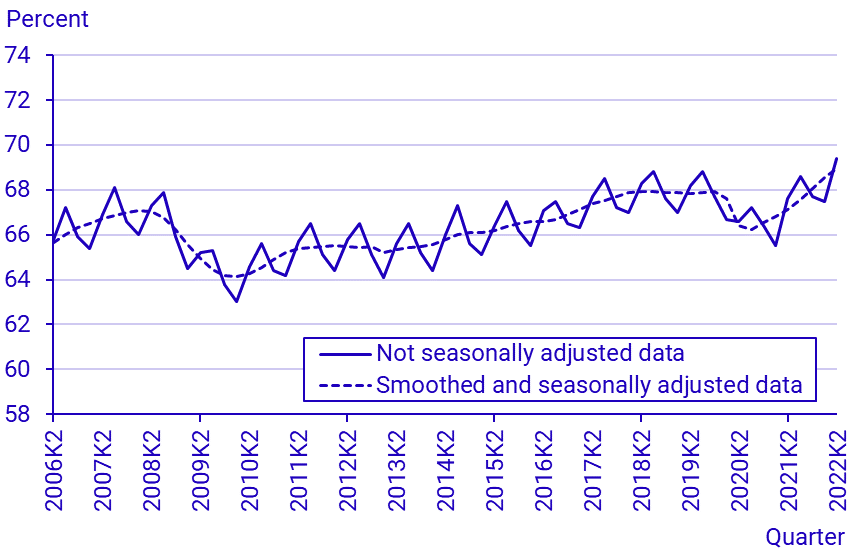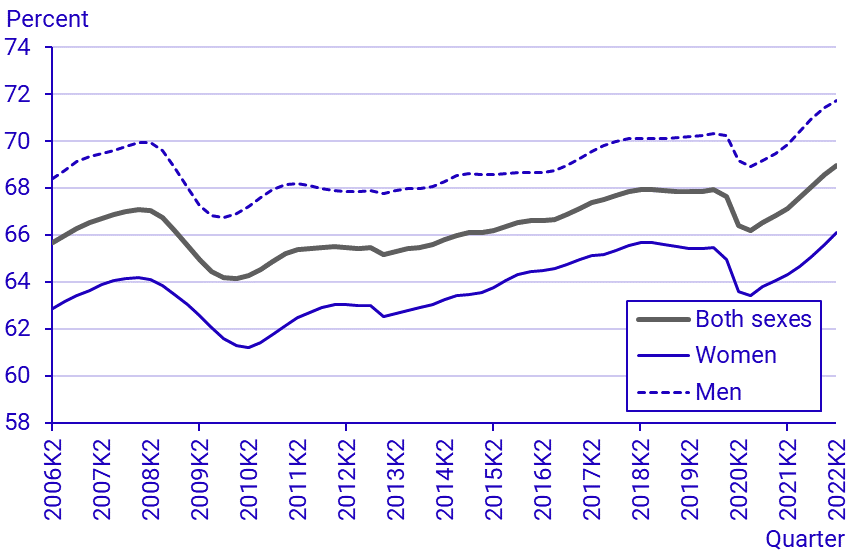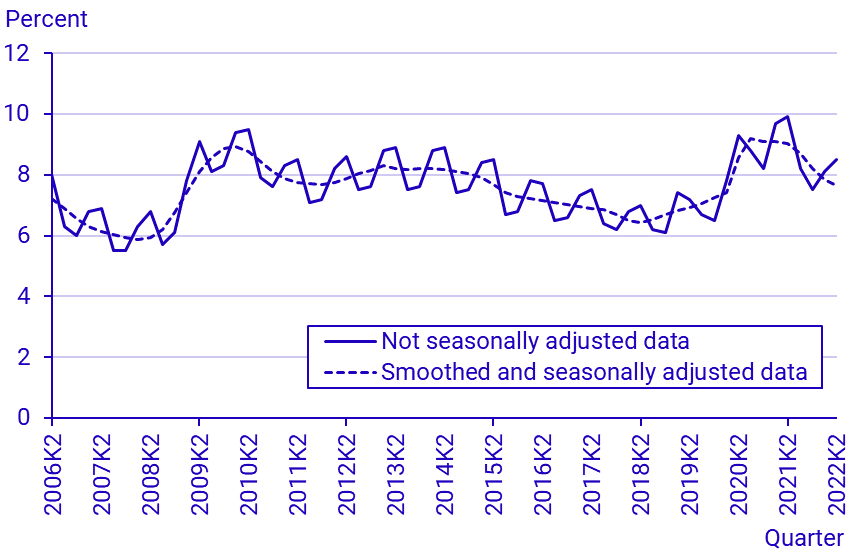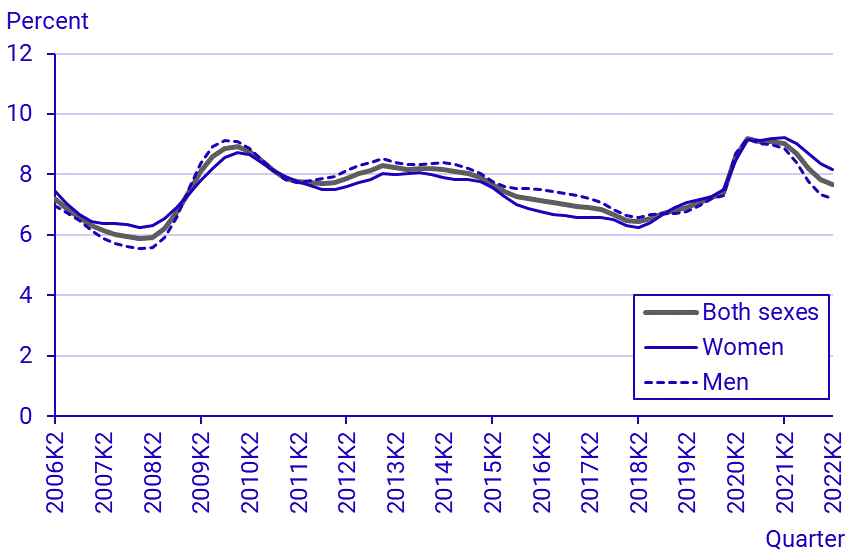Labour Force Surveys (LFS), second quarter 2022
Increased employment among Swedish born and foreign born
Statistical news from Statistics Sweden 2022-08-18 8.00
In the second quarter of 2022, there were 5 228 000 employed persons, not seasonally adjusted. This is an increase of 154 000 persons compared to the second quarter of 2021. The average number of hours worked per week increased by 2.7 percent in calendar-adjusted figures. The unemployment rate was 8.5 percent, a decrease of 1.4 percentage points. Seasonally adjusted and smoothed data shows an increase in employment, and a decrease in unemployment. The employment rate amounted to 69.0 percent and the unemployment rate was 7.7 percent.
The labour force
The number of persons in the labour force aged 15-74 years was 5 712 000 in the second quarter of 2022, not seasonally adjusted, which amounts to an increase of 82 000 persons compared to the second quarter of 2021. The number of women in the labour force increased by 47 000 to 2 712 000, and the number of men in the labour force increased by 34 000 to 2 999 000. The relative labour force participation rate was 75.8 percent, an increase of 0.8 percentage points. Among women it increased by 1.2 percentage points to 73.3 percent, and among men it was 78.2 percent.
Seasonally adjusted and smoothed data shows an increase in the number and share of persons in the labour force compared with adjacent quarters. In the second quarter of 2022, there were 5 628 000 persons in the labour force, which corresponds to 74.7 percent of the population.
Employment
In the second quarter of 2022, there were 5 228 000 persons aged 15–74 in employment, not seasonally adjusted, which is an increase of 154 000 compared to the corresponding quarter a year ago. There were 2 470 000 employed women, an increase of 70 000, and the number of men increased by 84 000 to 2 759 000 employed men. The employment rate increased by 1.8 percentage points to 69.4 percent. Among women, the employment rate was 66.7 percent, an increase of 1.7 percentage points. Among men, it was 72.0 percent, an increase of 1.9 percentage points.
Seasonally adjusted and smoothed data indicates an increase in both the number and share of employed persons compared with adjacent quarters. In the second quarter of 2022, there were 5 197 000 employed persons, which corresponds to an employment rate of 69.0 percent.
Employees
In the second quarter of 2022, there were 4 715 000 employees, not seasonally adjusted, which is an increase of 123 000 compared to the corresponding quarter of the previous year. Among those, 2 319 000 were women, an increase of 43 000, and 2 396 000 were men, an increase of 79 000. There were 3 941 000 permanent employees, an increase of 86 000. Among permanent employees, the number of women was 1 888 000 and the number of men increased by 65 000 to 2 053 000. There were 774 000 temporary employees. Among them 430 000 were women, and the number of temporary employed men amounted to 343 000.
According to seasonally adjusted and smoothed data, the number of employees was 4 683 000. The corresponding figure for permanent employees was 3 939 000, and for temporary employees 744 000. Compared with adjacent quarters, seasonally adjusted and smoothed data shows an increase in the number of employees, in permanent employees and in temporary employees.
Hours worked
The average number of hours worked per week in the second quarter of 2022 amounted to 159.3 million hours, not seasonally adjusted. In calendar-adjusted figures, this corresponds to an increase of 2.7 percent compared with the second quarter of 2021. Seasonally adjusted and smoothed data indicates an increase in the average number of hours worked per week compared to adjacent quarters. The number of hours worked averaged to 155.1 million per week.
The majority of employed persons have an agreed working time of 35 hours or more per week, that is, full-time work. In the second quarter of 2022, 4 143 000 persons worked full time, which is an increase of 158 000 persons compared to the second quarter of 2021. Among them 1 804 000 were women, an increase of 77 000, and the number of men increased by 82 000 to 2 340 000. In total, 289 000 persons worked short part-time (1–19 hours) and the number of persons that worked long part-time (20-34 hours) decreased by 43 000 to 618 000 persons.
The average actual hours worked among employed persons aged 15–74 years amounted to 30.5 hours per week in the second quarter of 2022. This is 0.8 fewer hours than in the second quarter of 2021. Women worked 28.1 hours per week, down 0.8 hours, and men worked 32.6 hours per week, down 0.9 hours.
Underemployment
Among employed persons aged 15–74, 292 000 were underemployed in the second quarter of 2022, a decrease of 37 000 persons compared to the second quarter of 2021. Among the underemployed persons, 146 000 were women, a decrease by 21 000, and 146 000 were men. Underemployed persons accounted for 5.6 percent of employed persons.
Unemployment
In the second quarter of 2022, there were 483 000 unemployed persons aged 15-74, not seasonally adjusted, which is a decrease of 72 000 persons compared to the second quarter of 2021. This corresponds to an unemployment rate of 8.5 percent, a decrease of 1.4 percentage points. There were 243 000 unemployed women, and 241 000 unemployed men, a decrease of 49 000. The unemployment rate for women decreased by 1.1 percentage points to 8.9 percent, and the male unemployment rate decreased by 1.8 percentage points to 8.0 percent.
Among persons aged 15–74, seasonally adjusted and smoothed data shows decreases in both the number and share of unemployed persons, compared to adjacent quarters. In the second quarter of 2022, there were 431 000 unemployed persons, which corresponds to an unemployment rate of 7.7 percent.
There were 191 000 unemployed young persons aged 15–24, not seasonally adjusted. This corresponds to an unemployment rate of 26.0 percent, a decrease of 4.1 percentage points. Among unemployed young persons, 118 000 were full-time students.
Among young persons aged 15–24, seasonally adjusted and smoothed data shows a decrease in the share of unemployed persons compared with adjacent quarters. The number of unemployed young persons amounted to 143 000, corresponding to an unemployment rate of 21.6 percent.
Not in the labour force
The group 'not in the labour force' includes persons who are not classified as employed nor as unemployed. In the second quarter of 2022, there were 1 824 000 persons not in the labour force, a decrease of 55 000 compared to the second quarter of 2021. Among them, 991 000 were women, a decrease of 38 000, and 834 000 were men.
Among persons not in the labour force, there were 877 000 retired persons. Furthermore, the number of full-time students decreased by 57 000 and amounted to 437 000. There were 276 000 persons who reported that they were on long-term sick leave, an increase of 35 000.
Latent job seekers
There were 235 000 latent job seekers aged 15–74 years in the second quarter of 2022. Among young people aged 15–24, there were 100 000 latent job seekers.
Unused labour supply
Unemployed persons, underemployed persons and latent job seekers together comprise the unused labour supply. In the second quarter of 2022, the unused labour supply averaged 23.3 million hours per week, which is 3.8 million hours less compared to the second quarter of 2021. The unused labour supply corresponds to 583 000 full-time employments with 40-hour work weeks.
Labour market for persons aged 20-64 years
The population presented by the LFS is comprised of persons aged 15–74 years. However, labour market participation among younger and older in this age group is considerably lower for natural reasons, as this group contains large shares of students and retired persons. To better approach what can be seen as the core of the actively working population, the situation of the age group 20–64 years is described in the following section.
The relative labour force participation rate among persons aged 20–64 years amounted to 88.5 percent in the second quarter of 2022, not seasonally adjusted. For women, the relative workforce participation rate was 85.9 percent, and for men it was 91.0 percent. Seasonally adjusted and smoothed data shows an increase in the labour force participation rate compared to adjacent quarters, which amounted to 87.9 percent.
In the second quarter of 2022, the share of employed persons aged 20–64 was 82.7 percent, not seasonally adjusted, an increase of 1.6 percentage points compared to the second quarter 2021. For women, the corresponding figure increased by 1.4 percentage points and was 79.9 percent. For men, it increased by 1.8 percentage points and was 85.3 percent. Seasonally adjusted and smoothed data shows an increase in the employment rate compared to adjacent quarters, which was 82.3 percent.
According to not seasonally adjusted data, the unemployment rate in the age group 20–64 amounted to 6.6 percent, a decrease of 1.6 percentage points compared to the second quarter of 2021. The unemployment rate for women was 7.0 percent, down by 1.3 percentage points. The male unemployment rate decreased by 2.0 percentage points and amounted to 6.2 percent. Compared with adjacent quarters, seasonally adjusted and smoothed data shows a decrease in the share of unemployed persons, which was 6.4 percent.
Swedish born and foreign born persons aged 20–64 years
The relative labour force participation rate among Swedish born persons aged 20–64 years was 89.6 percent in the second quarter of 2022, not seasonally adjusted. Among Swedish born women, the relative participation rate amounted to 87.8 percent, and among Swedish born men it was 91.3 percent. Among foreign born persons aged 20–64 years, the relative participation rate was 85.6 percent in the second quarter of 2022. The corresponding figure was 80.9 percent among foreign born women, and 90.2 percent among foreign born men. Compared with adjacent quarters, seasonally adjusted and smoothed data shows an increase in the labour force participation rate for both Swedish and foreign born persons. The labour force participation rate amounted to 88.9 percent among Swedish born persons, and it was 85.0 among foreign born persons.
In the second quarter of 2022, the share of employed Swedish born persons aged 20–64 was 86.3 percent, which is an increase of 0.9 percentage points compared to a year ago, not seasonally adjusted. Among Swedish born women, the employment rate was 84.9 percent. Among Swedish born men it increased by 1.2 percentage points to 87.7 percent. Among foreign born persons, the employment rate was 72.5 percent, an increase of 3.8 percentage points. The employment rate for foreign born women rose by 4.2 percentage points to 66.4 percent. For foreign born men it increased by 3.6 percentage points to 78.6 percent. Seasonally adjusted and smoothed data shows an increase in the employment rate compared to adjacent quarters for both Swedish born and foreign born persons. The employment rate was 85.9 percent among Swedish born and 72.1 percent among foreign born persons.
The relative unemployment rate among Swedish born persons aged 20–64 years was 3.6 percent in the second quarter of 2022, a decrease of 1.2 percentage points compared to the second quarter of 2021. Among Swedish born women, the unemployment rate decreased by 0.9 percentage points and was 3.3 percent. The male unemployment rate among Swedish born was 3.9 percent, down by 1.5 percentage points. The unemployment rate among foreign born persons was 15.3 percentage points, down by 3.3 percentage points. For foreign born women it was 17.9 percent, and for foreign born men it was 12.9 percent, a decrease of 3.6 and 3.2 percentage points, respectively. According to seasonally adjusted and smoothed data, unemployment decreased compared with adjacent quarters and amounted to 3.4 percent among Swedish born persons and 15.1 percent among foreign born persons.




Definitions and explanations
Since the LFS is a sample survey, the results are subject to some uncertainty. The LFS basic tables contain uncertainty figures and refer to non-seasonally adjusted data.
Seasonally adjusted and smoothed data (trend values): data in which normal seasonal variations have been removed, then smoothed to reduce sampling error and short-term variations. Seasonally adjusted and smoothed data may be revised following new monthly outcomes and usually does not coincide with non-seasonally adjusted data. Seasonally adjusted and smoothed data is not to be compared with non-seasonally adjusted data.
More detailed results are available in the form of figures and tables on employed persons, hours worked, unemployed persons and more, on Statistics Sweden’s website.
Next publishing will be
2022-08-26, at 08:00.
Feel free to use the facts from this statistical news but remember to state Source: Statistics Sweden.
